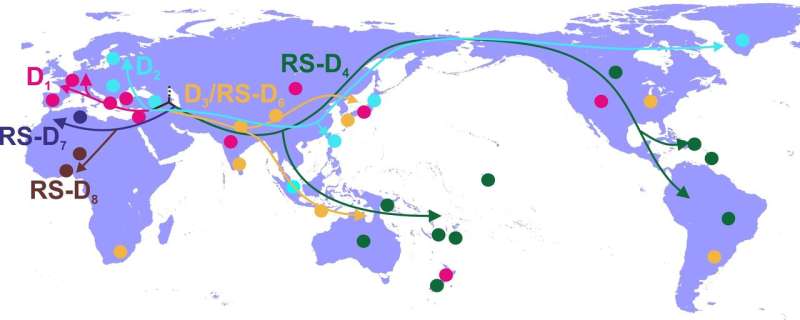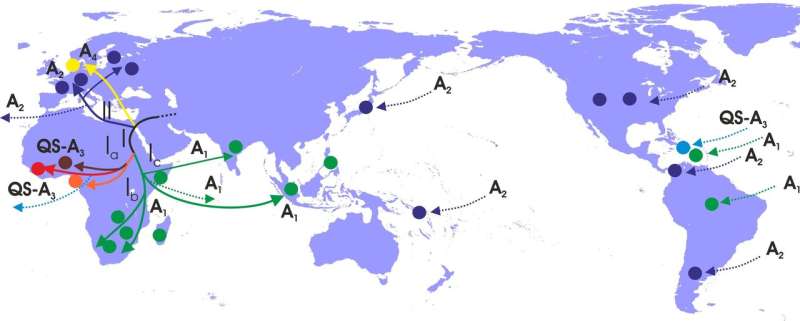Putative major dispersal pathways of HBV-D. The origin is depicted with a dotted black line. Subgenotypes and their corresponding dispersal routes are shown with different colors. Colored circles depict the geographic areas where subgenotypes are the most prevalent. Credit: Kostaki et al., 2018
Researchers have provided new insight on the geographical origins and global spread of two classes of the hepatitis B virus (HBV), according to a study in eLife.
The findings identify the HBV genotypes D and A (HBV-D and HBV-A) as having originated in the Middle East and North Africa. They also reveal considerable differences in the global dissemination patterns of these genotypes, adding to our understanding of both the historic and prehistoric spread of one of the world's largest viral pandemics.
HBV, the main cause of liver disease, is a global public health concern with an estimated 257 million people living with the infection, according to figures from the World Health Organization. The virus is classified into nine genotypes (A-I). HBV-A and HBV-D are present around the globe, with A prevailing in Europe and Africa and D in Europe and the Middle East.
"The epidemiological history of HBV-D and HBV-A remains unclear due to a lack of relevant studies," says lead author Evangelia-Georgia Kostaki, Ph.D. Candidate in Molecular Epidemiology at the National and Kapodistrian University of Athens, Greece. "In order to uncover more of this detail, we wanted to establish how HBV was disseminated across different geographic regions."
Putative major dispersal pathways of HBV-A. The putative geographic origin of genotype A is in the Middle East/Central Asia. Subgenotypes and their corresponding dispersal routes are shown with different colors. Colored circles depict the geographic areas where subgenotypes are the most prevalent. Dotted lines represent the source and sinks for distant dispersal pathways. Credit: Kostaki et al., 2018
To do this, the team used 916 HBV-D and 493 HBV-A full-genome sequences to reconstruct these genotypes' global evolutionary development and diversification, known as their phylogeny, and analyse their levels of regional clustering. They revealed that HBV-D's geographical origin was in North Africa and the Middle East, although they were unable to infer the exact origin accurately from the available data. Their analysis also suggests the origin of HBV-A is close to Africa and Europe, and likely in the Middle East and Central Asia.
"Major dispersal pathways for HBV-D were complex, including different geographic regions," explains senior author Dimitrios Paraskevis, Assistant Professor of Epidemiology and Preventive Medicine at the National and Kapodistrian University of Athens. "We found low levels of HBV-D transmission occurred locally in North Africa and the Middle East, suggesting a high amount of movement among populations infected with HBV in these areas. This is in line with our previous observations about the central role of these regions as hubs for human expansion, due to the early development of agriculture and the resulting spread and genetic shuffling of HBV-D."
Paraskevis adds that after HBV-A's initial spread in Central Africa, this genotype followed two distinct pathways: one to eastern and southern Africa, and another to sub-Saharan and western Africa. Spillovers later led to major regional transmissions towards Brazil, Haiti and the Indian subcontinent, most likely as a result of the slave trade.
Together, these results highlight considerable differences in the global dissemination patterns of HBV-D and HBV-A, as well as different levels of their regional clustering, which likely reflect the impact of prehistoric and more recent human migrations and other activities on the evolution of these HBV genotypes.
More information: Evangelia-Georgia Kostaki et al, Unravelling the history of hepatitis B virus genotypes A and D infection using a full-genome phylogenetic and phylogeographic approach, eLife (2018). DOI: 10.7554/eLife.36709
Journal information: eLife
Provided by eLife






















